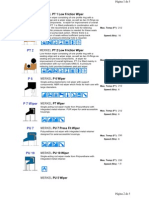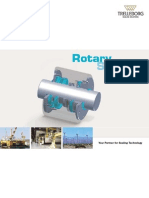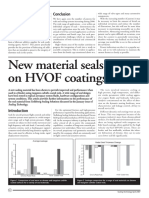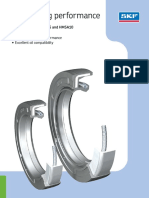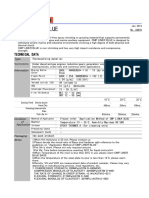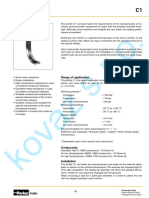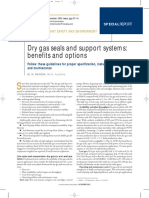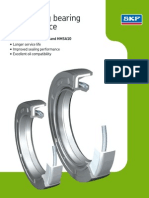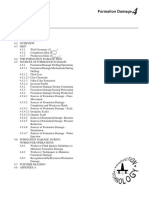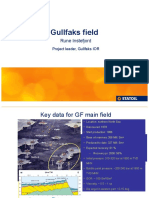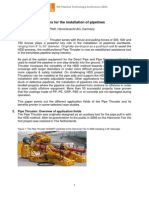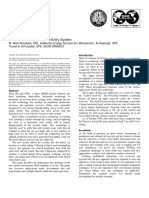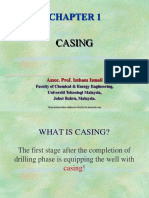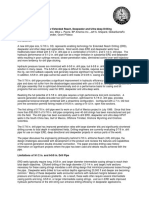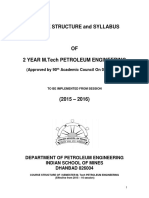B02 HNBR
B02 HNBR
Uploaded by
Surendra RathoreOriginal Description:
Original Title
Copyright
Available Formats
Share this document
Did you find this document useful?
Is this content inappropriate?
Report this DocumentCopyright:
Available Formats
B02 HNBR
B02 HNBR
Uploaded by
Surendra RathoreCopyright:
Available Formats
Kalsi Seals Handbook
Chapter B2
HNBR seal material
Revision 6 September 30, 2020
Individual chapters of the Kalsi Seals HandbookTM are periodically updated. To determine if
a newer revision of this chapter exists, please visit https://www.kalsi.com/seal-handbook/.
NOTICE: The information in this chapter is provided under the terms and conditions of the Offer of
Sale, Disclaimer, and other notices provided in the front matter of this seal handbook.
Document 3052 © 2020 Kalsi Engineering, Inc. All rights reserved.
HNBR seal material Chapter B2 Page 1
1. Seal material profile: HNBR
ASTM designation: HNBR
Common names: Hydrogenated Nitrile
Highly Saturated Nitrile
HSN1
Saturated Nitrile
Trade names: Therban (Mobay)
Zetpol (Zeon Chemical)
Tornac (Polysar)
General material description
Compared to NBR seal materials, HNBR offers outstanding abrasion resistance,
good resistance to swelling and flex cracking, and improved temperature, chemical and
compression set resistance. The improvements are gained by reducing unstable double
bonds through saturation with hydrogen. The typically quoted temperature range for
HNBR is -50 to 320°F (-46 to 160°C).2 This is 70°F (39°C) hotter than the typically
quoted maximum continuous operating temperature of NBR.
HNBR has a good overall balance of characteristics (chemical, abrasion,
compression set resistance, etc.) for typical oilfield drilling service, and is widely used in
that industry.
2. HNBR selection guidelines
Introduction
HNBR is the most common material used to manufacture Kalsi-brand rotary shaft
seals. The available compounds are shown in Table 1, and the various hardness
combinations available in Dual DurometerTM rotary seals are shown in Table 2.
The softer compounds
The 65 to 75 durometer hardness compounds (-14, -16, and -17) are used almost
exclusively as the outer, energizing portion of our Dual Durometer shaft seals. The 70
1 When HNBR was initially developed, it was commonly known as HSN.
2 With HNBR seal materials, one obvious sign of extended exposure to excessive heat is material
embrittlement.
Contact Kalsi Engineering Search this handbook
HNBR seal material Chapter B2 Page 2
durometer, -14 material is a popular dual durometer energizing material because it has
better compression set resistance than the 65 durometer, -17 compound, and provides
lower interfacial contact pressure than the 75 durometer, -16 compound.
The 80 durometer, -10 compound
The -10, 80 durometer seal material, is often recommended for low differential
pressure conditions, such as oilfield rotary steerable tools, where shaft seals with lower
running and breakout torque may be desirable. The compound is also a candidate for
certain low differential pressure applications that may operate in unusually cold
environments, such as oilfield surface equipment, mining equipment, and remotely
operated underwater vehicles. We have successfully started -10 Wide Footprint-type
shaft seals at -40°F (-40°C) in our laboratory.
Wide Footprint SealsTM made from the -10 HNBR compound have been
satisfactorily tested in low differential pressure conditions at 302°F (150°C) with an ISO
32 viscosity grade lubricant and a wide range of our typically recommended axial spring
loads.
The -11 compound
The -11 compound has a hardness range of 85 to 92 durometer Shore A, and
typically runs about 87 to 88 durometer. It is the most popular compound for Wide
Footprint and Axially Constrained Kalsi SealsTM, which are widely used as oilfield mud
motor seals. We have performed a great many rotary tests with this material at
temperatures up to 302°F (150°C) and pressures up to 1,500 psi (10.34 MPa) at speeds
simulating oilfield drilling operations.
The -11 compound was the first HNBR seal material ever adopted by Kalsi
Engineering. It was adopted at a time when true 90 durometer HNBR compounds were
unavailable. Although the -11 compound has a long history of success in high
differential pressure service, the -15 material offers superior high pressure extrusion
resistance, and should be considered in cases where seal geometry and radial cross-
sectional depth are compatible with the -15 compound.
The 90 durometer, -15 compound
The 90 durometer, -15 compound offers better high pressure extrusion resistance
than the -11 compound, however it is not recommended for Axially Constrained Seals,
and seals that have a small radial cross-sectional depth.
Contact Kalsi Engineering Search this handbook
HNBR seal material Chapter B2 Page 3
The -15 compound is presently the most popular dynamic lip material for dual
durometer shaft seals. Because of the longstanding acceptance and popularity of the -11
compound, the -15 compound is currently underutilized in single durometer seals. We
believe that many customers who use the -11 compound in high differential pressure
service would be better served by the -15 compound. For example, the fixed location,
pressure retaining seal of a mud motor is a prime candidate for the -15 compound, if it
meets the cross-sectional depth criterion described below.
The -15 compound has been qualified for Wide Footprint Seals that have a 0.345”
(8.76mm) or greater radial cross-sectional depth. The -15 compound has also been
qualified in Wide Footprint Hybrid SealsTM in radial cross-sectional depths of 0.305”
(7.75mm) or greater, using a ratio of two Type C enhanced lubrication waves to every
one zigzag wave.3 Since the Type C wave is the least aggressive Enhanced
LubricationTM wave, the -15 compound is also compatible with more aggressive wave
patterns.
Higher than anticipated hydrodynamic leakage has been observed with Type C
waves when used with the -15 compound. Before using this combination, consult the
relevant test data, and make sure your lubricant reservoir is adequately sized. No such
leakage affect has been observed when the -15 material is used with the zigzag waves of
second generation Wide Footprint Seals.
The 95 durometer, -18 compound
The 95 durometer, -18 compound offers better high pressure extrusion resistance
than the -15 compound, however it is only used as the inner lip material of a -107, -114,
or -115 Dual Durometer shaft seal.
3. Environmental considerations
Using HNBR with diesel-based drilling fluids
Significant swelling of HNBR can occur with #2 diesel-based oil well drilling fluid.
This is particularly the case with low aniline point diesel fuel. Differential pressure,
barrier seals, and/or rotary seal spring loading should be used to help to minimize
swelling when low aniline point environments are anticipated. If possible, drillers should
consider the aniline point when specifying diesel-based drilling fluids. Due to its adverse
effect on elastomers, low aniline point diesel muds should be avoided when possible.
3 Our tests of 0.270" (6.86mm) radial cross-section, PN 641-19-11 and 641-19-15 Type C Wide
Footprint Enhanced Lubrication SealsTM indicate that the -15 material no longer provides a benefit over
the -11 material seal in such small cross-section Type C seals. As of this writing, the -15 material has
not been tested in 0.270” radial cross-section seals that have more aggressive enhanced lubrication
wave patterns.
Contact Kalsi Engineering Search this handbook
HNBR seal material Chapter B2 Page 4
Kalsi Engineering successfully performed a 500 hour, 250°F (121°C), 1,000 psi
(6.89 MPa) rotary test with 7.2 lb/gal “neat” (i.e. 100% diesel fuel) #2 diesel-based
drilling fluid using HNBR (85 to 92 Durometer Shore A) seals at a surface speed of 346
ft/minute (1.76 m/s). In rotary seal testing with other swell-inducing fluid media,
however, swelling caused a significant reduction in high pressure extrusion resistance.
To reduce the risk of swell-induced loss of extrusion resistance, an outboard barrier seal
can be used to protect the high pressure shaft seal from the swell-inducing environment.
In applications with differential pressure, very little of the surface area of the rotary
seal is actually exposed to and soaked by the drilling fluid. This helps to minimize
swelling. In the aforementioned 1,000 psi lab test, swelling of the seal was limited to the
small portion that was directly exposed to the drilling fluid at the extrusion gap between
the seal carrier and the shaft. In low differential pressure applications, axial spring
loading of the seal can also be employed to minimize swelling by establishing sealing
contact pressure with the environment side groove wall. Similar to differential pressure,
spring loading limits the area of the rotary seal that can be exposed to the drilling fluid.
Special precautions with winterized diesel based drilling fluids
Diesel-based drilling fluids are often more aggressive to HNBR seals in the
wintertime due to the lower viscosity/condensate type winterizing additives. Benzene is
even sometimes encountered in diesel-based drilling fluids on a seasonal basis, and
dramatically reduces the life of HNBR-based rotary seals.
When using HNBR in the fixed location, higher differential pressure seal position
of a downhole mud motor, the material(s) of the barrier seal(s) and the compensation
piston sliding and rotary seals should be selected based on anticipated chemical
exposure if winterized diesel-based drilling fluids are anticipated.
Using HNBR with brine-based drilling fluids
While HNBR is resistant to the salt solutions sometimes encountered in oil well
drilling, and has good compatibility with water, steam, and formate brine, it is poor
against zinc bromide and fair to poor against calcium bromide. Both bromides are
sometimes encountered in brine drilling fluids. When using HNBR in the fixed location,
high pressure seal position of a downhole mud motor, the material(s) of the outboard
barrier seal should be selected for bromide resistance if brine-based drilling fluids are
anticipated. FEPM and FKM are suggested as candidate barrier seal materials.
H2S
Contact Kalsi Engineering Search this handbook
HNBR seal material Chapter B2 Page 5
HNBR is generally considered to be acceptable with concentrations of up to 7%
H2S at temperatures up to 300°F (149°C). At higher temperatures or concentrations, use
FKM or FEPM. FEPM is preferred to FKM if explosive decompression is a concern.
Contact Kalsi Engineering Search this handbook
HNBR seal material Chapter B2 Page 6
Known media limitations:
Avoid benzene, zinc bromide, calcium bromide (may cause embrittlement), CaBr
formates, strong acids, halohydrocarbons (carbon tet, trichlorethylene), ketones (MEK,
acetone), esters. Slight deterioration occurs when exposed to the lubricant additive zinc
dithiophosphate. High acrylonitrile (ACN) content is desirable for use with drilling
fluids based on No. 2 diesel fuel.
Other resources on chemical compatibility
It is not practical to include comprehensive media compatibility information in this
handbook, nor is it necessary in view of the available specialty literature. One such
reference is the book Chemical Resistance Guide for Elastomers IV by Kenneth M.
Pruett (Compass Publications, La Mesa, CA USA: 2014).
Table 1
Available HNBR materials for single durometer rotary seals
Material hardness,
Material dash no. Material description Shore A Durometer
-10 HNBR (fully saturated, 80 ±5
peroxide cured, up to
43% ACN)
-11 HNBR (peroxide cured, 85 to 92
up to 43% ACN)
-14 HNBR 70 ±5
-15 HNBR 90 ±5
-16 HNBR 75 ±5
-17 HNBR 65 ±5
Contact Kalsi Engineering Search this handbook
HNBR seal material Chapter B2 Page 7
Table 2
HNBR material combinations for Dual Durometer rotary seals4
Inner lip hardness, Outer Lip hardness,
Material dash no. Shore A Shore A
-100 80 ±5 65 ±5
-101 85 to 92 65 ±5
-102 90 ±5 65 ±5
-104 80 ±5 70 ±5
-105 85 to 92 70 ±5
-106 90 ±5 70 ±5
-107 95 ±5 70 ±5
-108 80 ±5 75 ±5
-109 85 to 92 75 ±5
-110 90 ±5 75 ±5
-112 85 to 92 80 ±5
-113 90 ±5 80 ±5
-114 95 ±5 80 ±5
-115 95 ±5 85 to 92
4 Techniques have been developed to manufacture our rotary seals in most hardness combinations
without the need for special tooling.
Contact Kalsi Engineering Search this handbook
You might also like
- Study Guide For Petroleum EngineersDocument65 pagesStudy Guide For Petroleum Engineersankurume1984No ratings yet
- Catalog WiperDocument24 pagesCatalog WiperRicardo RivasNo ratings yet
- C06 Hybrid Kalsi SealsDocument5 pagesC06 Hybrid Kalsi SealsMhd TvkliNo ratings yet
- Rado - Hydrogenated NBR Elastomer (HNBR), 2021 +Document4 pagesRado - Hydrogenated NBR Elastomer (HNBR), 2021 +oreamigNo ratings yet
- Mechanical SealDocument6 pagesMechanical SealysudharnnanNo ratings yet
- Rotary Seals VringsDocument25 pagesRotary Seals VringsPatrick BaridonNo ratings yet
- E01 Using Kalsi Seals in Rotating Control DevicesDocument16 pagesE01 Using Kalsi Seals in Rotating Control DevicesnagarajakumarNo ratings yet
- Klueberfluid C-F 3 ULTRA IngleseDocument2 pagesKlueberfluid C-F 3 ULTRA Ingleseseegna100% (3)
- Klueberfluid C-F 3 ULTRADocument2 pagesKlueberfluid C-F 3 ULTRAwajahat ali KhanNo ratings yet
- Lubrication and Dust Prevention of Ball Screw PDFDocument1 pageLubrication and Dust Prevention of Ball Screw PDFERIC RODRIGUEZ HERNANDEZNo ratings yet
- C03 Wide Footprint Kalsi SealsDocument7 pagesC03 Wide Footprint Kalsi Sealsruzzo2003No ratings yet
- Wellcare Oil Tools PVT LTD: Product IndexDocument22 pagesWellcare Oil Tools PVT LTD: Product IndexParag PadoleNo ratings yet
- New Material Seals Better On HVOF CoatingsDocument2 pagesNew Material Seals Better On HVOF Coatingssandbad2100% (2)
- Reten SKFDocument12 pagesReten SKFJozmel Blancas CamarenaNo ratings yet
- CMP Liner Blue: CMP LNR BL CMP LNR BL CMP LNR BL CMP LNR BLDocument2 pagesCMP Liner Blue: CMP LNR BL CMP LNR BL CMP LNR BL CMP LNR BLRiki AkbarNo ratings yet
- Kovaz S.r.o.: Rod SealDocument5 pagesKovaz S.r.o.: Rod SealAyman AlhalfawyNo ratings yet
- 810-701 CRSeals Handbook KeyTerms Apr-2018Document1 page810-701 CRSeals Handbook KeyTerms Apr-2018Anonymous VNu3ODGavNo ratings yet
- 810-701 CRSeals Handbook GREASE Apr-2018Document3 pages810-701 CRSeals Handbook GREASE Apr-2018Anonymous VNu3ODGavNo ratings yet
- Dry - Gas - Seal - Blowdown PDFDocument5 pagesDry - Gas - Seal - Blowdown PDFchemsac2No ratings yet
- Data SF 2400Document2 pagesData SF 2400Francisco SalazarNo ratings yet
- Klubersynth GE 46 1200Document2 pagesKlubersynth GE 46 1200karenglzNo ratings yet
- 0901d196802a343c-6234 5 EN-Maximizing-performance TCM 12-129176Document12 pages0901d196802a343c-6234 5 EN-Maximizing-performance TCM 12-129176WojciechNo ratings yet
- 6234 5 EN-Maximizing-performance PDFDocument12 pages6234 5 EN-Maximizing-performance PDFSridhar TholasingamNo ratings yet
- Castrol Longtime PD1 & PD2 Product Data SheetDocument3 pagesCastrol Longtime PD1 & PD2 Product Data SheetAmit NaikNo ratings yet
- Maximizing Bearing PerformanceDocument12 pagesMaximizing Bearing PerformanceJurun_Bidanshi100% (1)
- Lit Fta156 TechDocument12 pagesLit Fta156 TechNaser JahangiriNo ratings yet
- Lit SLD InstallDocument8 pagesLit SLD InstallchennagotfanNo ratings yet
- Rubber World HNBR Article - Therban AT PDFDocument9 pagesRubber World HNBR Article - Therban AT PDFAnusha Rajagopalan100% (1)
- 810-701 Crseals Handbook Metal Face Apr-2018Document5 pages810-701 Crseals Handbook Metal Face Apr-2018Anonymous VNu3ODGavNo ratings yet
- 810-701 CRSeals Handbook PRESSURE Apr-2018Document4 pages810-701 CRSeals Handbook PRESSURE Apr-2018Anonymous VNu3ODGavNo ratings yet
- Hydrogenated Nitrile For Oilfield ApplicationsDocument6 pagesHydrogenated Nitrile For Oilfield ApplicationsHuỳnh TGNo ratings yet
- Kluberfluid C F 3 UltraDocument2 pagesKluberfluid C F 3 UltraSathykumar MurugesanNo ratings yet
- Example of Downhole Completion Equipment: © 2011 IFP TrainingDocument66 pagesExample of Downhole Completion Equipment: © 2011 IFP TrainingArmansyah Sofyan100% (2)
- Destec G RangeBrochureDocument16 pagesDestec G RangeBrochureltrongluanvn100% (2)
- 810-701 Crseals Handbook Rotary Shaft Apr-2018Document86 pages810-701 Crseals Handbook Rotary Shaft Apr-2018Anonymous VNu3ODGavNo ratings yet
- Castrol Aditivo MicrofluxDocument3 pagesCastrol Aditivo MicrofluxmaykolperezrojoNo ratings yet
- Staburags Nbu 30 PTMDocument2 pagesStaburags Nbu 30 PTMYogi PamungkasNo ratings yet
- Hempel Shopprimer 15890ZSDocument2 pagesHempel Shopprimer 15890ZSAnuar SalehNo ratings yet
- Bpxe 8wsee6Document2 pagesBpxe 8wsee6EricNo ratings yet
- SK SDW20 Web 201605 ENDocument4 pagesSK SDW20 Web 201605 ENmehdiNo ratings yet
- Fretting/Corrosion in Main Bearing Bore: Service Letter SL2017-645/JNNDocument4 pagesFretting/Corrosion in Main Bearing Bore: Service Letter SL2017-645/JNNkaarthik saaiNo ratings yet
- EagleBurgmann Pipeline & Process Equipment GasketDocument28 pagesEagleBurgmann Pipeline & Process Equipment GasketЮляNo ratings yet
- Flexitallic 2100Document2 pagesFlexitallic 2100Gonzalo Alonso QuintanaNo ratings yet
- 810-701 CRSeals Handbook v-RING Apr-2018Document27 pages810-701 CRSeals Handbook v-RING Apr-2018Anonymous VNu3ODGavNo ratings yet
- Make Bearings Live Longer.: Plain Bearing Lubrication: Product Selection and TipsDocument24 pagesMake Bearings Live Longer.: Plain Bearing Lubrication: Product Selection and TipsMario MullerNo ratings yet
- Effect of Various Efficient Vulcanization Cure Systems On The Compression Set of A Nitrile Rubber Filled With Different FillersDocument10 pagesEffect of Various Efficient Vulcanization Cure Systems On The Compression Set of A Nitrile Rubber Filled With Different FillersMartin BarrientosNo ratings yet
- Article On Dry Gas Seals PDFDocument7 pagesArticle On Dry Gas Seals PDFanoopthazhath100% (1)
- SKF Large Diameter Seals InsertDocument116 pagesSKF Large Diameter Seals InsertAlexander Daniel Gonzalez AguilarNo ratings yet
- SKF - Large Diameter Seals - 6404 Eng PDFDocument116 pagesSKF - Large Diameter Seals - 6404 Eng PDFDiegoAlvarezHuguezNo ratings yet
- Hempadur Zinc 17360Document2 pagesHempadur Zinc 17360Krishna Vacha100% (1)
- Dry Gas Seals and Support Systems: Benefits and Options: Plant Safety and EnvironmentDocument5 pagesDry Gas Seals and Support Systems: Benefits and Options: Plant Safety and EnvironmentMuzammil SaleemNo ratings yet
- E0909Document6 pagesE0909ahmedbeaetNo ratings yet
- Klingersil: Optimum Flange SecurityDocument7 pagesKlingersil: Optimum Flange SecurityjbertralNo ratings yet
- ArticleDocument6 pagesArticletotojul1No ratings yet
- DryGasSealsDocument6 pagesDryGasSealsNoman Abu-FarhaNo ratings yet
- PV LimitDocument9 pagesPV Limitadam100% (1)
- Residential Asphalt Roofing Manual Design and Application Methods 2014 EditionFrom EverandResidential Asphalt Roofing Manual Design and Application Methods 2014 EditionNo ratings yet
- Formation Damage: Geometry Comp ProductionDocument46 pagesFormation Damage: Geometry Comp ProductionkarunakarandctNo ratings yet
- Completions Company. Baker Oil ToolsDocument32 pagesCompletions Company. Baker Oil ToolsHamid Reza BabaeiNo ratings yet
- ACT Flow Irons CatalogueDocument56 pagesACT Flow Irons CataloguePHILIPUAENo ratings yet
- Tesco True Results Casing Running in China Results in Total Depth PDFDocument2 pagesTesco True Results Casing Running in China Results in Total Depth PDF123456ccNo ratings yet
- Directional DrillingDocument25 pagesDirectional Drillingsuhrab samiNo ratings yet
- Simulation Throughout The Life of A ReservoirDocument12 pagesSimulation Throughout The Life of A ReservoirjuanseferrerNo ratings yet
- 13 3-8" Cementing Program ChecklistDocument2 pages13 3-8" Cementing Program ChecklistYougchu LuanNo ratings yet
- Managed Pressure Drilling StatoilDocument37 pagesManaged Pressure Drilling StatoilWaleed Barakat Maria100% (1)
- Seismic-While Drilling Applications From First DrillCAM Trial With Wireless Geophones and Instrumented Top DriveDocument8 pagesSeismic-While Drilling Applications From First DrillCAM Trial With Wireless Geophones and Instrumented Top DriveAndrey BakulinNo ratings yet
- Squeeze Remedial CementingDocument4 pagesSqueeze Remedial CementingMahesh MahajanNo ratings yet
- SyllabusDocument3 pagesSyllabuswreckiebNo ratings yet
- Window Milling - Cement WhipstockDocument9 pagesWindow Milling - Cement WhipstockAdel Ahmed AlkhaligyNo ratings yet
- B11 313 Stuck Pipe Conference 20130928 From Conference ProceedingsDocument9 pagesB11 313 Stuck Pipe Conference 20130928 From Conference ProceedingsAl-Shargabi MohaNo ratings yet
- A Review On Gas Well Optimization Using ProductionDocument11 pagesA Review On Gas Well Optimization Using ProductionAnil BikkinaNo ratings yet
- PPLI Company ProfileDocument15 pagesPPLI Company ProfilesetyoNo ratings yet
- 7-Gullfaks IOR ScreeningDocument31 pages7-Gullfaks IOR ScreeningMuhammad Umair Zahid Abbasi100% (1)
- PTC 2014 PfeffDocument9 pagesPTC 2014 Pfeffromvos8469No ratings yet
- Safe Carb PsDocument2 pagesSafe Carb PsangelogobNo ratings yet
- The Purpose of Casing in Drilling ProcessDocument2 pagesThe Purpose of Casing in Drilling ProcessIslam MohamedNo ratings yet
- IADC/SPE 59209 A New Selective Lateral Re-Entry SystemDocument6 pagesIADC/SPE 59209 A New Selective Lateral Re-Entry SystemJorge FernandoNo ratings yet
- Indonesia Oil and Gas Fields Atlas Vol. 6 Eastern Indonesia 1988Document12 pagesIndonesia Oil and Gas Fields Atlas Vol. 6 Eastern Indonesia 1988kiri list your email t.No ratings yet
- Chapter 1+Casing+12Feb18Document47 pagesChapter 1+Casing+12Feb18Mohamad ZakwanNo ratings yet
- Beginner's Guide To PetrophysicsDocument14 pagesBeginner's Guide To PetrophysicsPetro Man100% (1)
- Formation Pressure Evaluation: Acquisition and InterpretationDocument12 pagesFormation Pressure Evaluation: Acquisition and InterpretationAlejandroMendozaNo ratings yet
- Mud LoggingDocument29 pagesMud LoggingDavidandy0% (1)
- Fundamentals of Casing Design Petroleum Engineering and Development Studies by H. RabiaDocument17 pagesFundamentals of Casing Design Petroleum Engineering and Development Studies by H. RabiaNugroho100% (1)
- Onva SolutionsDocument8 pagesOnva SolutionsjibamnildoNo ratings yet
- Next Gen Drill PipeDocument12 pagesNext Gen Drill PipeHenry Garavito RamirezNo ratings yet
- Syllabus of Masters in Technology in Petroleum Engineering Course at IIT (ISM), Dhanbad, IndiaDocument13 pagesSyllabus of Masters in Technology in Petroleum Engineering Course at IIT (ISM), Dhanbad, IndiaAfzal AktharNo ratings yet

